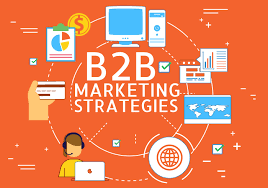Mastering B2B marketing can be a daunting task. Unlike B2C marketing, which targets individual consumers, B2B marketing involves selling products or services to other businesses. With its unique challenges and complexities, B2B marketing requires a strategic approach to attract and convert leads into customers. In this comprehensive guide, we will explore the meaning of B2B marketing, the differences between B2B and B2C marketing, effective branding strategies, successful B2B marketing examples, the latest trends, and best practices to achieve B2B marketing success.

Understanding B2B Marketing
B2B marketing, short for business-to-business marketing, refers to the marketing strategies and content used by one business to target and sell to another business. This type of marketing is commonly employed by companies that offer services, products, or SaaS solutions to other organizations. The ultimate goal of B2B marketing is to attract and convert leads into customers by capturing their attention through educational content such as white papers and value-driven blog posts.
Differences Between B2B and B2C Marketing
B2B and B2C marketing differ significantly in terms of their target audiences and approaches. B2C marketing focuses on individual consumers who purchase products or services for personal use, often driven by desire or impulse. On the other hand, B2B marketing targets businesses or groups looking to solve specific challenges within their organization. B2B marketing involves longer sales funnels due to the involvement of multiple decision-makers in the purchasing process.
To effectively market to B2B customers, it is crucial to understand their pain points and address them with relevant solutions. Unlike B2C customers, B2B customers prioritize value and return on investment (ROI) over impulse buying. By tailoring marketing strategies to the specific needs and challenges of B2B customers, businesses can effectively engage and convert them into long-term customers.
The B2B Marketing Process
Before diving into B2B marketing strategies, it is essential to understand the buyer journey. A B2B buyer’s journey typically consists of three main stages: awareness, consideration, and decision. During the awareness stage, the buyer realizes a problem and begins researching potential solutions. In the consideration stage, the buyer evaluates different solutions and their suitability for their specific needs. Finally, in the decision stage, the buyer makes a purchase decision based on the solution that offers the most value and fits their budget.
To effectively market to B2B customers, it is crucial to align marketing efforts with each stage of the buyer’s journey. This can be achieved by leveraging intent data for digital marketing, which allows businesses to target prospects who are actively searching for solutions. Additionally, businesses should focus on building and maintaining relationships with customers even after the purchase decision, utilizing strategies such as personalized email marketing.
Strategies for Effective B2B Marketing
To succeed in B2B marketing, businesses need to adopt strategies that focus on educating, providing value, and solving pain points for their target audience. As the majority of the buyer’s journey is now conducted digitally, businesses need to adapt their marketing strategies accordingly. Here are five essential strategies for effective B2B marketing:
- Establish Your Total Addressable Market (TAM): Begin by defining your ideal customer profile and determining your TAM. This ensures that you target the right leads for your business.
- Set Actionable Goals: Set clear and actionable goals for your marketing team members to optimize their performance. Track B2B marketing metrics and key performance indicators (KPIs) to measure progress.
- Develop a Compelling Value Proposition: Identify what sets your product or service apart from competitors and develop messaging and value drivers tailored to your target audience and key accounts.
- Plan Effective Outreach: Utilize the insights gained from the previous steps to plan and execute targeted outreach campaigns to drive revenue. Personalize content and leverage various channels such as email marketing
- Create Engaging Content: B2B content marketing is crucial for attracting, converting, and retaining buyers. Invest in creating valuable and informative content, including written, audio, and video formats, to build brand awareness and organic traffic.
By implementing these strategies, businesses can effectively engage with their B2B audience, offer value, and ultimately drive revenue.
Examples of Effective B2B Marketing Strategies
There are several proven B2B marketing strategies and activities that can contribute to revenue growth. Here are five examples:
- B2B Campaign Marketing: Plan and execute targeted campaigns to sell your product or service. Email marketing is often utilized, and campaign effectiveness can be measured through analytics.
- B2B Content Marketing: Develop and publish informative content across various channels to attract, convert, and retain buyers. Written, audio, and video content can be shared on blogs and social media platforms, driving organic traffic.
- B2B Digital Marketing: Leverage digital channels such as email, social media, paid advertising, and influencer marketing to promote your brand and connect with prospects. Establish a social media presence to build trust and credibility.
- B2B Performance Marketing: Combine digital channels with paid advertising, such as Google ads, to manage your company’s digital advertising spend, generate targeted leads, and build brand engagement.
- B2B Product Marketing: Build brand awareness and promote B2B products or services at scale. Focus on positioning, messaging, and value proposition. Utilize customer case studies, webinars, and sales collateral to encourage business audiences to make a purchase.
These strategies, when implemented effectively, can contribute to the success of B2B marketing campaigns and drive revenue growth.
Emerging Trends in B2B Marketing for 2024
B2B marketing is constantly evolving, driven by advancements in technology and changing market dynamics. Here are some emerging trends to watch out for in 2024:
- Hybrid Working Models: The COVID-19 pandemic has accelerated the adoption of hybrid working models, combining remote and in-person work. B2B marketers need to adapt their strategies to reach and engage with professionals in both physical and virtual environments.
- Virtual Events and Video Marketing: Virtual events have gained significant popularity, providing opportunities for B2B marketers to connect with audiences globally. Video marketing continues to grow as a powerful tool for engaging and educating prospects.
- The Dark Funnel: The dark funnel refers to the anonymous online research conducted by B2B buyers before engaging with a specific brand. B2B marketers need to find innovative ways to track and leverage this hidden data to understand buyer behavior and tailor marketing strategies accordingly.
- Underpriced Attention: Identifying and capitalizing on underpriced attention channels and platforms will become increasingly crucial in the B2B marketing landscape. Businesses should explore emerging platforms such as TikTok and leverage influencer marketing to reach their target audience.
- Data Tracking and Privacy Compliance: With increased reliance on data-driven marketing, businesses must prioritize data tracking while ensuring compliance with local privacy laws. Building trust and maintaining transparent customer relationships will be vital.
By staying up-to-date with these emerging trends and embracing innovation, B2B marketers can stay ahead of the competition and drive successful marketing campaigns.
Best Practices for B2B Marketing Success
To achieve success in B2B marketing, businesses should follow these six best practices:
- Develop a Comprehensive Marketing Plan: Start with a well-defined plan that outlines your goals, target audience, and strategies. Periodically review your plan and make necessary adjustments based on performance.
- Leverage the Power of Data: Utilize high-quality, GDPR-compliant data to personalize your marketing campaigns and target prospects effectively. Intent data can help you identify prospects who are actively in the market to buy.
- Create Engaging Visual Content: Enhance your marketing materials with visual assets such as videos, infographics, and high-quality images. Visual content increases engagement and strengthens your brand image.
- Establish a Strong Brand Identity: Define your brand persona, values, tone of voice, and visual identity. Consistency and transparency build customer loyalty and enhance your position in the B2B market.
- Focus on Addressing Pain Points: Understand your customers’ pain points and offer valuable solutions. Buyers want to be offered something that helps them solve their ongoing frustrations.
- Embrace Experimentation: B2B marketing is an ever-evolving field, so be open to experimentation and A/B testing. Stay updated on the latest trends and innovations in the industry to maximize your marketing revenue.
By implementing these best practices, businesses can align their marketing efforts with their sales goals and create a streamlined and successful B2B marketing strategy.
Conclusion
B2B marketing involves unique challenges and requires a strategic approach to attract and convert leads into customers. By understanding the differences between B2B and B2C marketing, businesses can tailor their strategies to effectively engage with their target audience. Implementing the right strategies, such as campaign marketing, content marketing, digital marketing, performance marketing, and product marketing, can contribute to revenue growth and success in the B2B market. By staying updated on emerging trends and following best practices, businesses can stay ahead of the competition and drive successful B2B marketing campaigns in 2024 and beyond.




No comments! Be the first commenter?